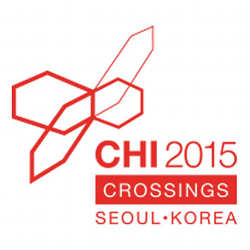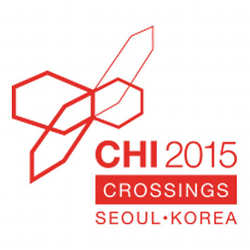
Interactivity, CHI’s showcase for interactive demos, kicked off on the first evening of the conference (April 20) in the main exhibition hall along with a huge opening reception. As this was in Seoul—at the first CHI conference held in Asia—the night had a special buzz to it. We were greeted by a troupe of traditional Korean dancers who performed several, highly skilled and beautiful routines (the best of which was, in my opinion, the one featuring precisely synced movements and drumming). All the while, conference-goers sipped drinks and snacked on tasty finger foods (including sushi rolls, chicken wings, and dumplings) while roaming the floor chatting with colleagues and checking out Interactivity and other exhibits.
Even though it‘s open for a couple of hours each day of the conference, Interactivity always seems as though it requires more time to explore fully, so it's good to get the lay of the land on opening night. It’s during this initial stroll that I often run into people who have contributed to Interactions. This is one of the best parts of being at the conference—getting to meet or catch up with people who write or edit for the magazine.
Another highlight of Interactivity is encountering hands-on examples of exciting new technologies that have been discussed in Interactions. We recently published an article by Jürgen Steimle on printed electronics, so it was nice to happen upon PaperPulse, a project presented by Raf Ramakers and colleagues from Hasselt University that uses some of the technologies discussed in Steimle’s article. PaperPulse is a simple kit for designing, printing, and assembling paper-based interactive projects, such as interactive placemats or paper-based games. It’s interesting that usable circuitry can be easily printed on regular paper using a cheap printer loaded with conductive ink.
In his Interactions article, Steimle mentioned wearable flexible interfaces that could be manufactured using similar printed circuitry processes, so I was also excited to see a presentation of one of his and his students' actual projects, iSkin—thin, flexible touch sensors that can be worn on the body and used to control various devices, such as music on an iPhone or keyboard input on a smart watch. In addition to enabling certain types of on-body control that would be impossible without this kind of technology, iSkin also has an aesthetic component. Many examples feature tattoo-like patterns, making them both stylish and functional. Gazing at the patterns, I was reminded of the Aestheticodes technology discussed by Steve Benford in another recent Interactions article.
Also on the topic of wearables and style, I was instantly drawn to the spacey musical sounds coming from a project around the corner. The sounds were triggered by a garment called Nebula, a black interactive cape featuring elaborate starscape-like patterns of metal studs. When the wearer moves his or her body, different clusters of studs touch each other, generating sequences of tones that are otherworldly sounding, yet completely tied to the movements of the wearer. While many other projects at Interactivity have very specific, very practical imagined uses, Nebula is an artistic, expressive project, more tied to performance and fashion than to solving problems. I am glad that imaginative projects like this continue to be featured there.
As with last year's conference, one of the coolest demos was a little off the beaten path. This was not due to some logistical snafu or abnormally large space requirement, but rather because this project needed sunlight. Listen Tree, situated in the sun-filled atrium near the registration desk, was a real ficus tree modified to be a living speaker. It was designed and built by Edwina Portocarrero and Gershon Dublon from the MIT Media Lab. Sounds are transmitted wirelessly to a transducer at the base of the tree, which channels them through the roots, trunk, and branches. Small holes drilled in the trunk emit sounds, which can be heard softly from a distance, but which invite listeners to come closer and place their ears right next to the trunk. At CHI, power came from the wall, but the duo has created Listen Trees in other cities that run off solar power. And because the tree itself is the sound conductor, it's no surprise that different types of trees have different resonating properties. When I heard Listen Tree, it was playing what sounded like ambient traffic sounds, but its voices can come from any source and thus "speak" in any language. This is in keeping with the spirit of the project which, Portocarrero explained, connects with the widespread appearance of talking trees in traditional folklore around the world. I also learned that several Listen Trees can be combined, each with different voices to form harmonies or full musical compositions. The sound I would like to hear is the Lord of the Rings trilogy's enormous deep-voiced, slow-talking Ents. But I imagine that might require a larger tree.
John Stanik is managing editor of ACM Interactions magazine.




Join the Discussion (0)
Become a Member or Sign In to Post a Comment